
Oolong is a traditional semi-oxidized Chinese tea produced through a process that includes withering the leaves under strong sun and allowing some oxidation to occur before curling and twisting. Most oolong teas, especially those of fine quality, involve unique tea plant cultivars that are exclusively used for particular varieties. The degree of oxidation, which is controlled by the length of time between picking and final drying, can range from 8% to 85% depending on the variety and production style. Oolong is especially popular in southeastern China and among ethnic Chinese in Southeast Asia, as is the Fujian preparation process known as the gongfu tea ceremony.
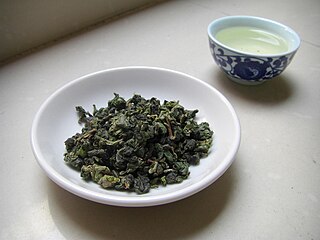
Tieguanyin is a variety of Chinese oolong tea that originated in the 19th century in Anxi in Fujian province. Tieguanyin produced in different areas of Anxi have different gastronomic characteristics.
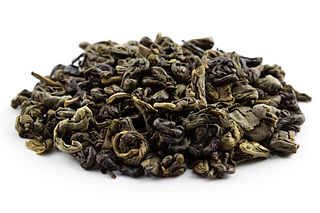
Gunpowder tea is a form of tea in which each leaf has been individually rolled into a small pellet. Its English name comes either from some resemblance of the pellets to gunpowder, or from a phrase in Chinese that phonetically resembles the word "gunpowder". This rolling method of shaping tea is most often applied either to green tea or to oolong tea.

Rougui tea is a variety of the tea plant, commonly grown in the Wuyi Mountains and processed into oolong tea. The name literally means "cassia". The tea can be difficult to prepare, but its distinctive sweet aroma can be brought out up to 7 steepings. It was first developed during the Qing dynasty.

Huang Meigui is a relatively new Wuyi oolong tea, developed c. 2002. It has a highly aromatic fragrance and a lighter floral taste than most other Wuyi oolongs.

Jin Fo tea is a Wuyi Oolong tea, developed at the Wuyi Shan Tea Researching Center located in Fujian Province, China. It is a medium Wuyi Oolong showing both creaminess and a floral aftertaste. The tea leaves have a uniform emerald green color.
Si Da Ming Cong is a collective term referring to four famous Wuyi oolong tea bush varieties and the tea beverages made from them, namely:
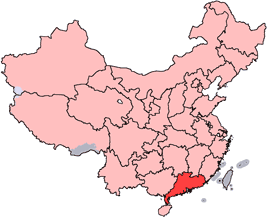
Yingde hongcha is a black tea from Yingde, Guangdong province, China. First produced mechanically in 1959. Much of the tea is exported. Some quality varieties are produced, which often look like leaf Oolong.

Tieluohan or Tie Luo Han is one of the Four Great Oolongs and a light Wuyi tea. Tieluohan is the cultivar responsible for one of the four best known Yán chá, "rock teas" grown on cliffs in the Wuyi Mountains in northern Fujian Province, China. Legend tells that this tea was created by a powerful warrior monk with golden-bronze skin, hence the name Tieluohan, which means "Iron Arhat" or "Iron Warrior Monk".

Bai Ji Guan or Bai Jiguan is a very light Si Da Ming Cong tea, a well-known oolong tea of Wuyi, in Fujian, China.
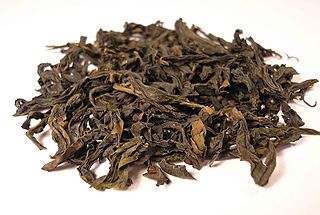
Qilan is a very mild Wuyi oolong tea. It has an obvious sweet and nutty aroma.

Ban Tian Yao is a very rare Wuyi Oolong with a light smokey taste.

Fo Shou is a Yongchun and Wuyi Oolong tea with a light and somewhat peculiar taste. It is also produced in Taiwan.
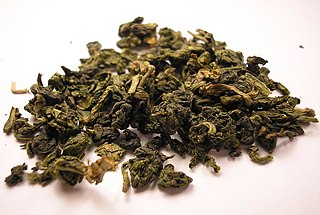
Huang Guanyin tea is a Wuyi oolong with a creamy taste. It can be either tightly rolled like Anxi Oolongs or in strips like conventional Wuyi Oolong.

Bu Zhi Chun is a Wuyi oolong with a light taste.

High-mountain tea or gaoshan tea refers to several varieties of Oolong tea grown in the mountains of central Taiwan. It is grown at altitudes higher than 1,000 metres (3,300 ft) above sea level, and includes varieties such as Alishan, Dayuling, Yu Shan, Wushe, and Lishan. The high humidity and natural precipitation in the high mountain ranges of Nantou and Chiayi Counties make the region a suitable environment for growing tea plants. High Mountain Oolong is a tea that holds all of its original nutrients that are within the unfermented green tea. It does not hold the usual grass-like taste, hints of chestnut flavor paired with nutty aromas are often described. The fermentation process that removes the harsh ingredients allows the tea to taste flavorful.

Taiwanese tea includes four main types: oolong tea, black tea, green tea and white tea. The earliest record of tea trees found in Taiwan is from 1717 in Shui Sha Lian (水沙連), present-day Yuchi and Puli, Nantou County. Some of the teas retain the island country's former name, Formosa.
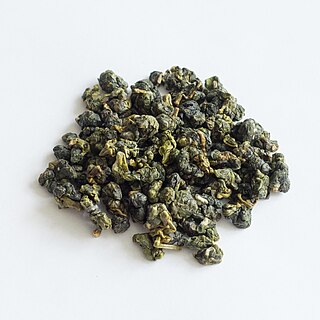
Jin Xuan is a variety of oolong tea developed in 1980. The tea is also known as #12 or as "Milk Oolong". It originates from Taiwan. The taste is light, creamy, and flowery and sometimes compared to milk. This tea variety can be grown at higher altitudes, and the yield is about 20% higher compared to traditional tea varieties. These circumstances made it one of the most popular varieties among tea farmers in Taiwan and Thailand. While genuine Jin Xuan naturally tastes milky, some producers produce artificial Jin Xuan through additives.

Dong Ding, also spelled Tung-ting, is an oolong tea from Taiwan. A translation of Dong Ding is "Frozen Summit" or "Icy Peak", and is the name of the mountain in Taiwan where the tea is cultivated. Those plants were brought to Taiwan from the Wuyi Mountains in China's Fujian Province about 150 years ago.


















